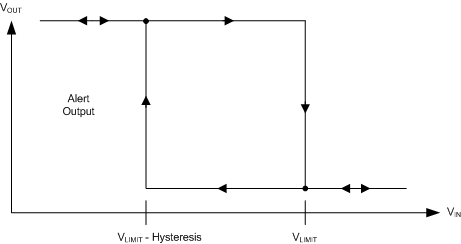ZHCSC46C February 2014 – June 2021 INA300
PRODUCTION DATA
- 1 特性
- 2 应用
- 3 说明
- 4 Revision History
- 5 Pin Configuration and Functions
- 6 Specifications
-
7 Detailed Description
- 7.1 Overview
- 7.2 Functional Block Diagram
- 7.3 Feature Description
- 7.4 Device Functional Modes
- 8 Application and Implementation
- 9 Power Supply Recommendations
- 10Layout
- 11Device and Documentation Support
- 12Mechanical, Packaging, and Orderable Information
7.3.5 Selectable Hysteresis
Device hysteresis is adjustable based on the setting at the hysteresis (HYS) terminal. The smallest setting for hysteresis on the device, 2 mV, is enabled by leaving the HYS terminal open and floating. A 4-mV hysteresis is set by connecting the HYS terminal to ground; connecting this terminal to the supply voltage sets the hysteresis to 8 mV, as shown in Figure 7-6. The HYS terminal must be either connected directly to ground, directly to supply, or left completely floating. Additional external resistors must not be connected to this terminal. If a resistance is required by the application to be placed in series with either the supply or ground connections to the HYS terminal, this resistance must be limited to 1 kΩ so as to not conflict with the internal level-detection circuitry.
 Figure 7-6 Hysteresis
Figure 7-6 HysteresisThe wide dynamic input range of the INA300INA300 necessitates an adjustable hysteresis to ensure that the device can be appropriately configured based on the specific operating conditions and application requirements. Figure 7-7 illustrates the transition locations for the ALERT terminal based on where the input signal, VIN, is measured relative the limit threshold, VLIMIT. The corresponding hysteresis levels and physical terminal settings for the device are shown in Table 7-5.
 Figure 7-7 Typical
Comparator Hysteresis
Figure 7-7 Typical
Comparator Hysteresis| HYSTERESIS | HYSTERESIS SETTING |
|---|---|
| Float | 2 mV |
| GND | 4 mV |
| VS | 8 mV |